

“There is nothing new under the sun, but there are new suns.” –Octavia Butler

45–50 minute conversation, or the time it takes to have lunch with someone you haven’t seen in a while.
Building new models for learning requires experimenting, ideating, and deep listening. For artists and educators American Artist and Shani Peters, this process is also artistic in itself: teaching and making are deeply entwined. Currently, each stewards an artist-run alternative school. American is co-director of the School for Poetic Computation (SFPC), a school, residency, and research group in New York, and Shani is co-founder and co-director of The Black School, an alternative art school teaching radical Black history in New Orleans. In the following conversation, Artist and Peters discuss the importance of rethinking traditional models, cultivating community, and inspiring curiosity within the classroom.
Allie Linn: To start from the beginning, what was your relationship to school and schooling growing up? I’m thinking about school generally here; this could be specific memories of educational spaces or the spaces you remember being the biggest catalysts for learning for you.
American Artist: A lot of my positive experiences of school I associate with specific teachers or educators that allowed for space where I could be creative or explore what I wanted. I remember a lot of the more determined parts of schooling being really boring and not really generative for wanting to learn. I remember that specifically about learning history. I found it extremely boring, and it wasn’t until, as an adult, that I found out how it could be interesting. So I feel like a lot of my education as a young person was about finding chances where I could be creative or throw myself and my energy into something that felt inspiring to me, even if that wasn’t necessarily what was designed for my experience to be.
Shani Peters: Two things come to mind: one in terms of going to school, like leaving my house and going to school. My older brother is super smart. He was valedictorian, and he didn’t go but he got into Harvard. He speaks, like, five languages now. So it was double-edged. He paved a nice, smooth path for me going to school. All of my teachers had already had him, so they were like, “Oh, okay, so you’re good.” It was probably easier than it could have been for me. Me, I did alright, in part thanks to that eased relationship, that well-buttered road. But I definitely think I’m dyslexic; I’ve never been diagnosed with it, but I struggled with reading early on and always had more academic challenges in school than my brother did. So even though I did well in school and was always perceived as smart internally and within my family, I never felt like I was on that same level. That was an insecurity in high school and younger, and so finding my way to the discipline of art and learning history through art, versus through those boring history classes, was watershed for me, because it showed me that there was a space where I could excel. There was a space where that came naturally, where I wasn’t fighting to be on that level. That was a big attraction with art.
I think the other thing that’s significant about my understanding of school early on is that my dad — he’s retired now — was a Black studies professor. We think about this a lot now with the work Joseph Cuillier and I are doing in The Black School. We think a lot about where Black people get our knowledge of Black history, and it tends to land at home. It tends to be that if you got it early on, before you came into a Black studies department, you probably got it from a family member, and my dad being a professor in the field made that even more articulated for me. From as early as I can remember, I was getting whole Black history lessons and a whole clearly-identified education from home.
Allie: You both named this piece of finding the parts of schooling that were inspiring in order to move along the parts that were less accessible or more boring or that didn’t resonate as much. Shani, you named art classes specifically; was art also the prime subject you were thinking of there, American, or were there other subjects that also played that role for you?
American: Yeah, I definitely think art classes were a catalyst, and not even necessarily the classes, but just having art as an outlet. I remember in elementary school this one comment that stuck with me was being told that I don’t use time wisely — that was something that was written on a report card — and I always think about that because even now I don’t feel like I use time wisely in the way that time is meant to be used. I’ll just put all of my energy into the one thing I care about, which happens to be art, and I think in school that was often the case. I would put a lot of time into drawing or doing things that were exciting for me, and I wouldn’t necessarily focus on the things that I was supposed to do, because it was being prescribed, so that very much felt like an outlet for me to find myself at that age.
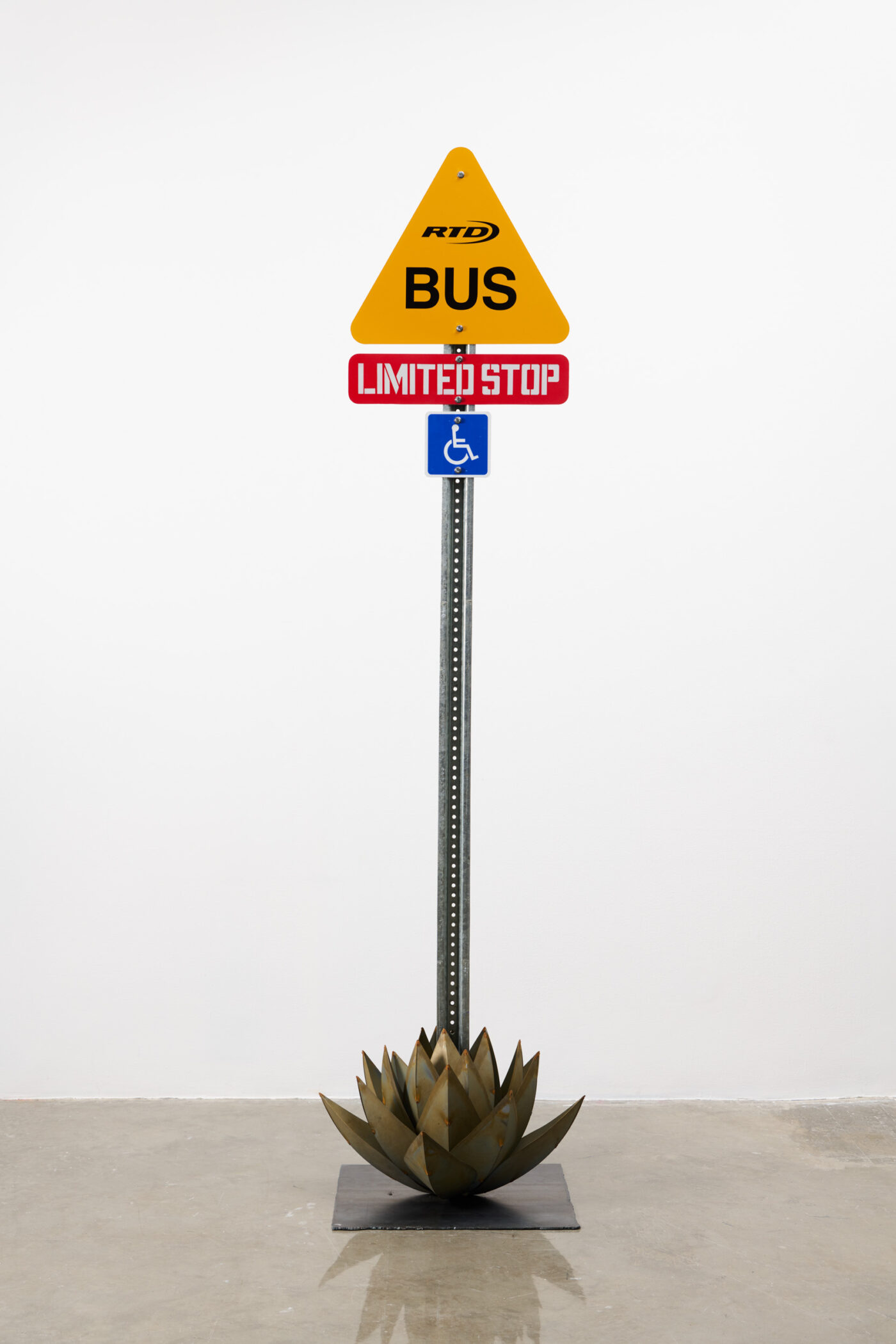
[ID: A yellow triangle street sign that reads, “Bus.” The base of the sign sits in an agave plant made of metal. It sits on a polished cement floor with a white wall background.]
As I started to make curriculum and pull together these different readings and projects, it started to feel like creating a class is also an art form, as well.
Allie: Moving into current practices, both of you move so seamlessly between a multitude of disciplines, with teaching being just one facet of a broader practice. Does it ever feel important to draw boundaries between these aspects of your practice, or do they become indistinguishable from each other?
Shani: I think the boundary is definitely blurred at this point because The Black School is a whole nonprofit now. We started as an art project and we became an LLC. We didn’t want to become a LLC, and then we had to do it for a small grant a long time ago, and then we had to become a nonprofit after crowdfunding donations. We have a whole hybrid org structure now that requires a different level of focus. The steep learning curve at the moment is the overwhelming focus of my practice. Also, it’s not hard to find ways to recognize how so much of this admin work is a way of making art and of making things possible. And that’s all aside from teaching. I still teach, I’m just teaching for my organization now.
Even before that, to speak to my relationship to teaching, I started working as a teaching artist for the reason that I think most artists do: to subsidize income to have something to rely on. But I realized within a few years that it was doing more for me than just that. Especially as an artist who has always been interested in working in community, always been interested in breaking out of the gallery and museum internal spaces and getting my work to be accessible to people who aren’t thinking about going into those spaces. It was clear that while we were trying to do that, while museums and organizations were breaking their backs to say they were doing a social practice project, any classroom — no matter how organized or unorganized I would step into — was actually doing that in all of these ways that the formal projects were not necessarily doing. Just in terms of actually reaching people, having an impact, having an impact on students, students having an impact on me, never leaving a classroom in the same mood you step into it, it will be transformed. I definitely realized early on that I actually like to teach, and it does solid things for me that I want my practice to also do, so leaning into that got me to a place where I’m willing to do all of the admin grunt work to creating this organization that we’re doing because I value it that much.
American: Yeah, I feel similarly. I didn’t realize earlier on, even in grad school, that I would end up teaching. I actually was really intimidated by that possibility; it just sounded like it would be overwhelming to take on fifteen to twenty-something students’ practices and have those running around in your mind for a long period of time, which is exactly what teaching was when I first started doing it. There was a certain amount of resistance when I first started doing it. It was a lot of work, but I also started to enjoy that. Realizing a lot of the things that Shani mentioned about wanting to be able to engage beyond the formal aspects of art, wanting to be in community with people, realizing how much I actually enjoyed thinking and talking about art with students, and being able to help them have these epiphanies that I had felt really good to me, so that’s something that I’m always trying to create in the teaching space as well.
As I started to make curriculum and pull together these different readings and projects, it started to feel like creating a class is also an art form, as well. Designing what that experience is going to be. How is it going to change and evolve over the course of the semester? What is expected of the students? What is the space of the classroom going to feel like? How are they going to feel excited or challenged or sad or happy? Being able to anticipate what that might look like is part of teaching and also feels very much like an art form as well.
More and more, I feel like those are just so interrelated that I have a hard time separating them. I think also with a lot of the work that I make it is very concept-based, and it feels important for me to try and inject whatever that idea is into people’s minds beyond what the art can do, so I find myself trying to use the work to teach, and also trying to teach about the work.
So it feels pedagogical and educational, even when that’s not explicitly what’s at stake. It all feels very much interrelated.
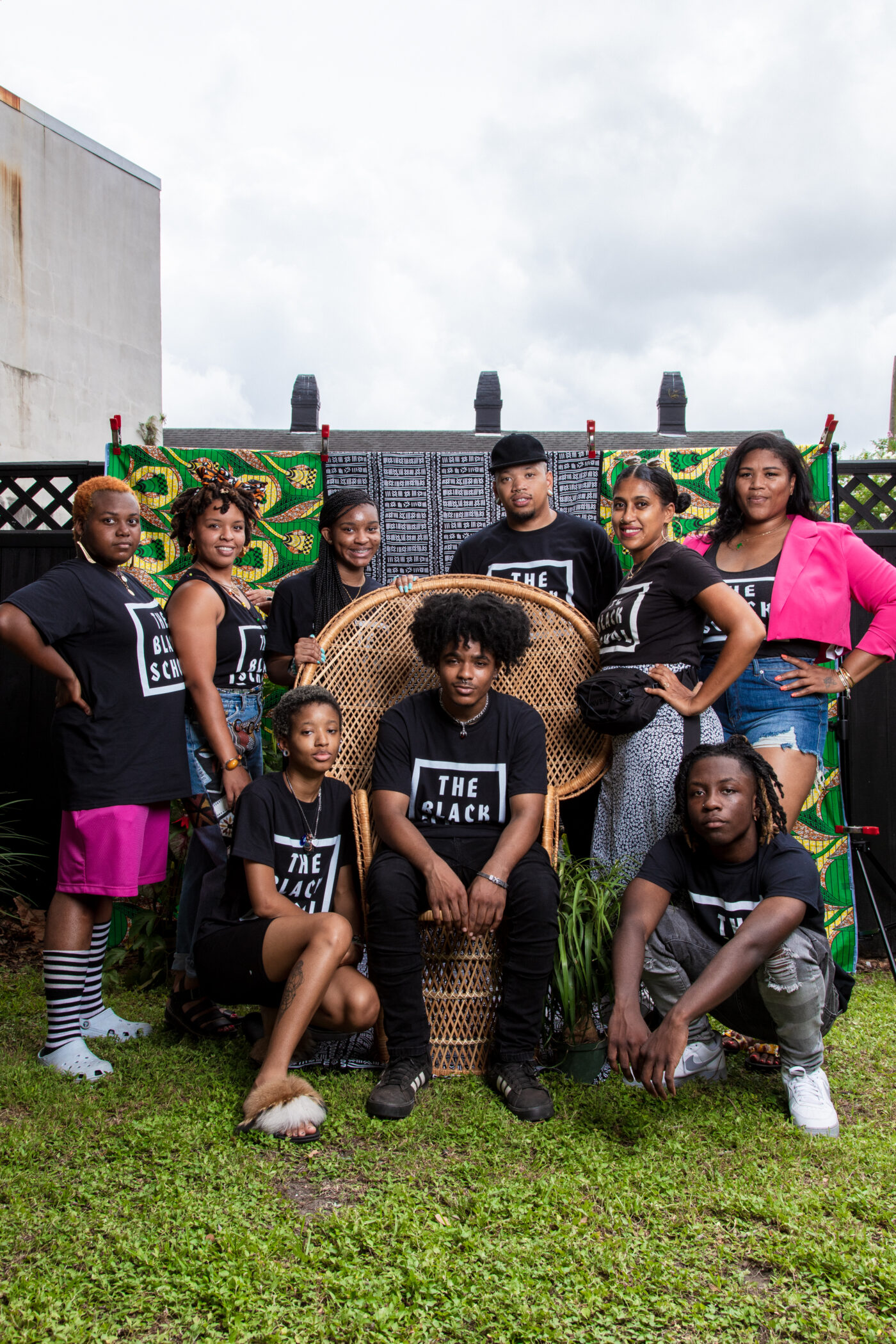
[ID: A portrait of ten people, including The Black School co-directors Shani Peters and Joseph Cuillier, outdoors, in and around a large wicker chair against a backdrop of graphic textiles. Everyone wears a black t-shirt with The Black School logo.]
Allie: And now each of you has stewarded an alternative school — Shani, from the founding of The Black School, and American, during a moment of reorganization for the School of Poetic Computation — amongst many other teaching roles. What has the process of building and rebuilding spaces for learning and shared knowledge been like? What has informed your imagining of what a school can be?
Shani: We started the organization in New York. I’m from Michigan, Joseph is from New Orleans, but we met in New York, and we started working there, where space is just such a premium, and I won’t say impossible — people have figured it out, The School of Poetic Computation has figured it out, which I was amazed by when I learned that, especially in that part of town — but we definitely took a lot of lessons from a New York organization, The Laundromat Project, who I worked with from the very beginning. I saw the way the organization grew and was familiar with how it was conceived at its founding, which is by a woman named Risë Wilson, who worked for foundations and saw a lot of organizations spending all of their operating budgets and going under because they were having to focus more on just keeping lights on than their programming. She thought of a way to have programming without that overhead, and it was imagining laundromats as these built-in, pre-existing community centers to be activated by programming.
So we took that approach to the ideas that we had for programming for The Black School. We dreamed it up. We collaborated with folks. We created lessons, syllabi, and then just took it to places that had space and people of multiple generations. That worked in ways we planned and ways we didn’t and gave us a lot of opportunity to experiment and try different things and learn as we built. That was definitely thinking of a space for learning and something that is not about physical, tangible space, but more about the people and how people can transform whatever confines or spaces they’re in.
A very big part of what we’re trying to do is create a new model. It is institution-building, but institutions don’t have to look like the institutions that we’ve had, so how do we learn and grow and propose something different?
The biggest disadvantage of all of that is that it’s hard to sustain relationships with people, because you’re going to a different place all the time. There were some advantages and that really significant disadvantage, and with both of us being educators and people deeply invested in seeing tangible outcomes from the ideas that we come up with, we both had a desire to work more sustainably and rooted in one place.
So that’s a big part of why we’re here now, to work with sustained presence. And that’s why we’re making sure that what we’re doing is actually desired by people here in the community so they can make use of it. Really, it’s a framework. I think what we’re doing now is essentially trying to create a framework that can hold a lot of different ideas and a lot of different possibilities and be filled in with people.
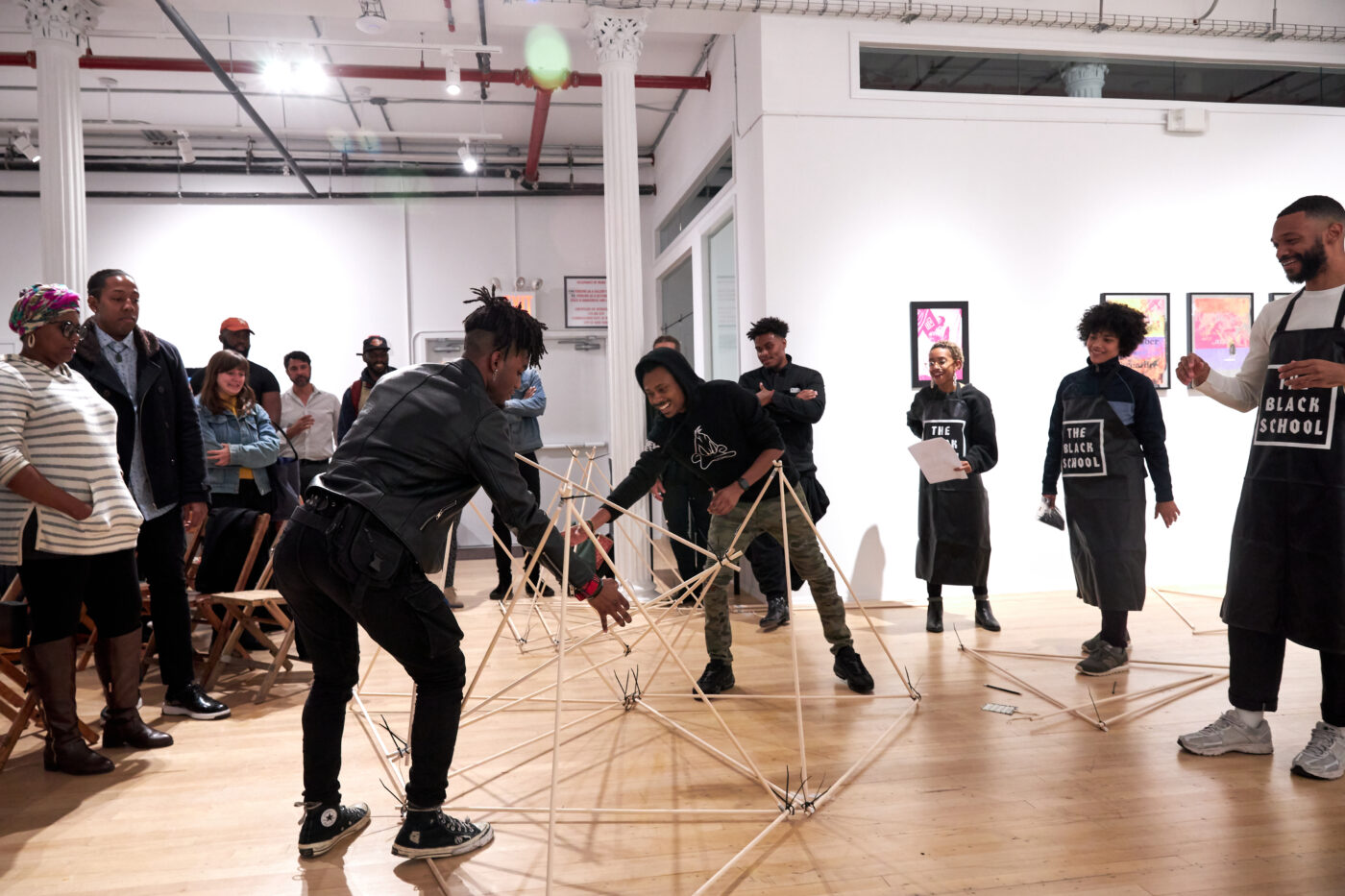
[ID: At the center of a circle of onlookers in a white-walled gallery space, two young people hover over a wooden pyramid frame. To their right are three people wearing aprons with The Black School’s logo.]
Allie: And in terms of building out the mission and the values of The Black School, has that been you and Joseph, or has that also been an ongoing project with all the different collaborators that you’ve been working with?
Shani: Yeah, I think it was definitely me and Joseph to start, but in the past year we have an operating budget now, and we’re able to employ ourselves, and other people, which is amazing. It feels so good to be able to offer people a job that they actually want to do. We have a team of folks now, and we were just on a call earlier today talking about succession planning.
A very big part of what we’re trying to do is create a new model. It is institution-building, but institutions don’t have to look like the institutions that we’ve had, so how do we learn and grow and propose something different? In that, we’re constantly thinking about documentation so that it is a shareable model. On this very internal level, we have to document me and Joseph’s internal understanding, so that this staff can understand what we’re trying to do, especially with us moving the organization into another city. Joe is from here, but he hasn’t lived in the city since he was five, so it needs to reflect this place, too.
The beautiful people that we’re able to bring into the organization give so much insight, so that needs to be built in, too. So we’re thinking about that right now. We dreamed up being able to have a staff retreat this year, and it’s looking like that’s going to come together, and that’s going to be the focus of it. This also happens every day as we work through all the things that we’re doing, but to really sit down and focus on putting down the mission statement, the principles. We have them, they’re written down, but really going through those together, reaching shared understanding, figuring out how that translates among the group of the whole team and then also how we translate that so that it’s an understanding that people feel when they come into the space. That’s the thing to be done collectively and a piece of our work that we’re now opening up first with the team that we have within the organization, and then immediately and simultaneously in a lot of ways with participants as we’re continuing to program.
It feels like something that’s coming more out of what we want that experience of study to be, first and foremost, and how we want to treat people and each other, and then everything else sort of happens around that.
Allie: I’m curious how that translates for you, American, as someone who didn’t necessarily found School for Poetic Computation, but, as you mentioned, you have begun to steward it with some other members of SFPC. What has that experience been like?
American: Yeah, I want to say that my idea of what a school can be is actually very heavily informed by my relationship to the School for Poetic Computation, because that was the first place that I taught. I had been invited by Melanie Hoff, who is one of the co-directors, to teach a short workshop. I taught something about software and ideology, and it was an experiment because I hadn’t taught something like that. It was really intense, but I felt like the way it resonated with the students and the feeling of teaching in that school was so energizing, and it was exciting for me to think about what a space of study could be. I ended up teaching their critical theory class and teaching a lot of work that is critical of technology, along the lines of race and racism and surveillance and colonialism within technology. That was something that I felt I wouldn’t necessarily have been invited to do by a typical university. They said you can design the classes as you see it, and so that was my early experience with teaching before I taught in a university. Moving into the university, it just never feels quite like my experience there, and so I feel like so much of what excites me about study in school has been informed by my experience at SFPC.
In the space that we’re in now, during the summer of 2020, around the time that there were protests in response to the murder of George Floyd and a lot of institutions were asking for accountability within their institutions for various forms of injustice or inequity, similarly, a lot of stewards and teachers of SFPC felt like, “Okay, how can our institution be better and be more accountable to those people that are participating and also to the stewards and teachers, as well?” A lot of us decided that we wanted to have more stake in the school and in designing what it can be and the values that it is going to represent. We laid that out and put ourselves forward to be like, “We want to have a stake in the school and help design what it’s going to be.”
Since then, we’ve stepped into these leadership roles and the past leadership has been helping us transition into these roles, but they’re no longer affiliated with the school. Now it’s seven of us as co-directors, designing what the school is going to be. The other co-directors were past students of mine or assistant teachers or other fellow teachers, so my understanding of this school feels directly out of what has happened in our classroom experiences. It doesn’t feel as bureaucratic and hegemonic as the university. It feels like something that’s coming more out of what we want that experience of study to be, first and foremost, and how we want to treat people and each other, and then everything else sort of happens around that.
Shani: You gotta tell me how you are all managing that. It could be notes we need going into our retreat.
American: It’s constantly trying to recalculate how this all fits together because it’s so atypical, but it feels really important.
Shani: Atypical is what we need. I think I’m so in the weeds of what we’re doing now that I’ll start answering questions and skip over a lot, and the basis is like, schools are trash. Burn it down from Pre-K to PhD. It’s not where it’s at. Rethinking all of it from top to bottom. That’s the first step and then everything else goes from that.
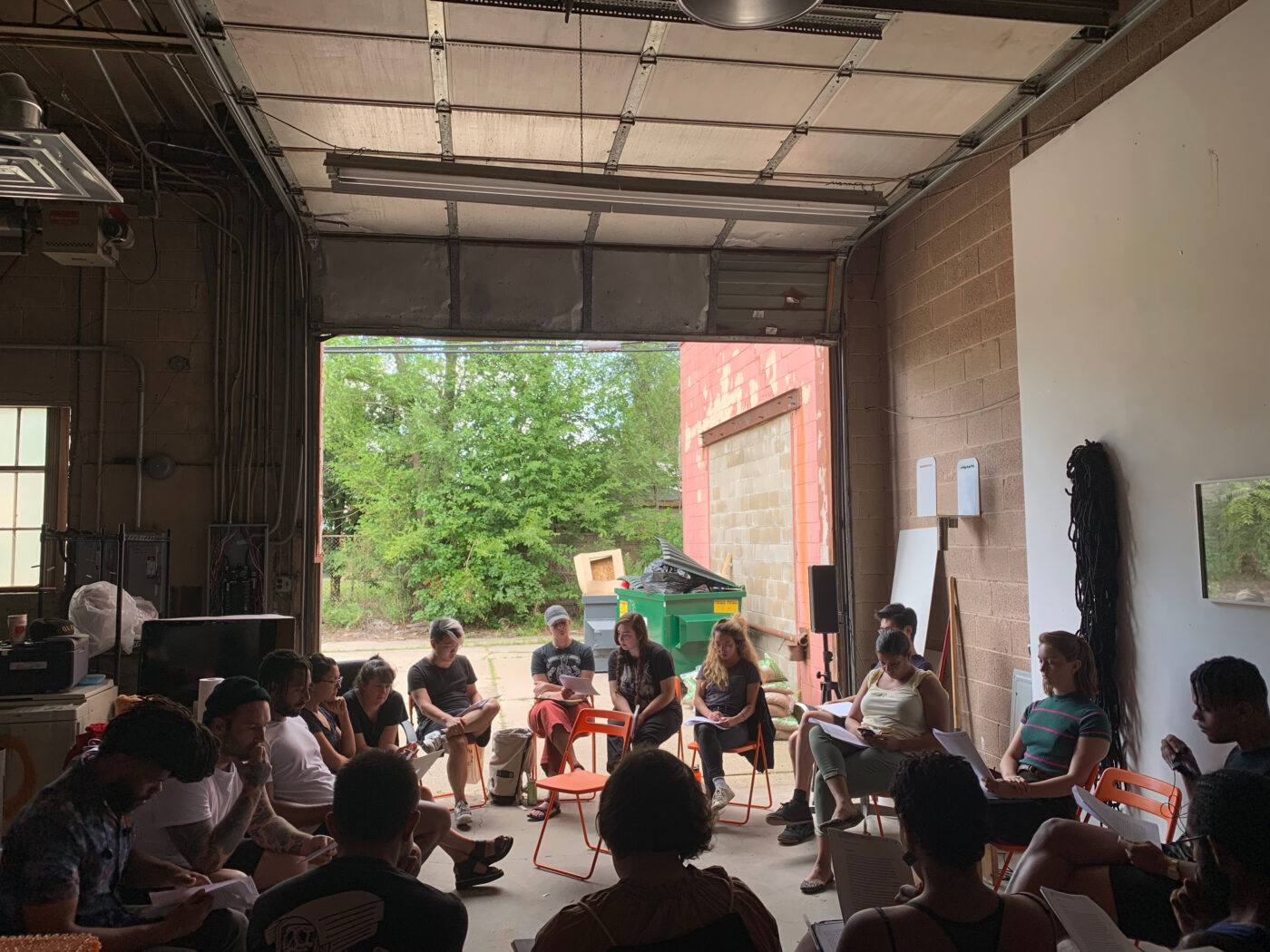
[ID: A photo of a high-ceiling garage taken from the inside facing the open door. Inside the garage, sixteen people are sitting on chairs forming a large circle. The people are looking down at reading material.]
Allie: You mentioned teaching at other institutions, American, and I’m sure you both have interfaced with a lot of different types of institutions: schools, museums, or otherwise. I’m curious if that work has informed your work with The Black School and with the School for Poetic Computation at all, as well.
American: Myself and the other co-directors, many of us have taught in universities and worked with these more established institutions. We all have a certain amount of skepticism and criticality towards those, and though I still feel very dependent on those work-wise, SFPC allows us to have a space where we can experiment with what a different model could be. I do feel like a lot of the positive or optimistic energy I have around what study can be goes towards SFPC and similarly, I feel like that is starting to seep into the space I hold in my classes, even if that is in the university. I want to protect the students or have a special engagement with them, even if the overall structure feels violent, for lack of a better word.
Shani: All of my experiences inform what we’re doing now. The positive and the negative experiences all inform this work positively. You learn what you don’t want to do, what you don’t want to replicate. The designated path for artists is to teach, especially on a college level, because you’re not going to make enough working as a teaching artist in schools. When I think about teaching and the kind of teaching that I love, it is primarily with younger people, and that’s primarily because of the inequities that exist in our society and who winds up being able to afford going to college. I definitely bring a ton from the experiences of working in middle schools, high schools, and seeing the difference between going into the built environment of a cinderblock school with no windows in the Bronx, and how the students respond to me and to the lesson in that space, versus being able to come into the Bronx Museum, whose building is partly renovated, and the education space in the new side is this beautiful modern architecture with floor to ceiling windows and the lights coming in. Similarly, the first place I started teaching was Harlem Textile Works, which no longer exists. There’s a real estate office running out of that space now. But it was a beautiful space specifically made for art-making and had a whole different impact on the way young people interface with the idea of making art. That has taught me a lot.
At the collegiate level, I’ve had both kinds of experiences because New York is such a special place. I did my master’s at City College, and I taught the longest there, and that student population is probably the most diverse on the planet. I really think that statement holds. That was my experience as a student there, too, that I definitely learned as much from my fellow classmates — we were from all over the world — as I did from the faculty. I had some great faculty, too. That’s not to undercount them.
I really enjoyed being able to teach there. I taught Art and Protest there. I got to design a class there on the history of Harlem with a survey of social practice that allowed people to actually do projects in Harlem. That class still exists and is being taught by a friend of mine, which is really beautiful, so I was always simultaneously deeply satisfied with my work at City College and also deeply underpaid. I would never have been able to attain a reasonable standard of living. I would never be able to put money in a savings account for my kid teaching solely at City College and living and paying New York expenses.
That’s really, more so than anything else, what motivated me to take positions when I was able to get them without an Ivy League degree. Getting a teaching position at Parsons or the private schools that are able to pay more of a living wage is very, very difficult, but eventually I was able to get some of those positions. I taught at Parsons and Pratt and they were super refreshing in some ways, to see what it’s like to have those resources, to see what it’s like for students to have the amount of credit hours dedicated to the classroom to really be able to explore things. It was amazing and also, simultaneously, deeply unsatisfying, because the inequity is right there. All of the classes that I was ever invited to teach were studying the inequity of how fucked up it all is, and the student population is represented in this room to no fault of these individuals here. They’re just moving through life in the world they were born into, but this is the problem. So you become a part of replicating it. I definitely had moments, and these were towards the end — thankfully I was able to transition into teaching for myself, exclusively or for an organization that I get to make decisions behind — but I had a moment of wondering, “Am I teaching people how to gentrify?” And feeling like, “I don’t like this.”
It’s also very empowering to have intimately been within those positions and to see how flawed they are, because they look so prestigious and they create this impostor syndrome you hear people talk so much about, this sense that things are just impossible and not attainable, where you’re getting people like me. Privilege creates this dynamic where people actually have less practice with managing difficult situations than the “underprivileged.” So in that way the “underprivileged” are actually more skilled and capable of taking on the challenges that exist in building something. So even when it’s overwhelming, it all makes me feel capable, because I’ve seen what it takes and how much money folks have in one space and how little they’re able to actually do with it.
Allie: You were also beginning to describe the physical architecture of some of those early educational spaces, and you were pointing to things like cinder block and walls and materials and windows. I’ve been thinking about architecture as such a big piece of this conversation, too. You both are building physical spaces as well as building new models for teaching and for learning. Maybe those were your only thoughts there, but if you had anything else to say as you’re thinking through physical space and architecture with the building of the schoolhouse for The Black School. Also for you, American, I saw you mentioned in the chat that the School for Poetic Computation has become virtual during the pandemic, as so many institutions have had to move to virtual learning, and how that has affected the teaching space.
Shani: Yeah, I think about the building all the time. I’ve Zoomed with architects every two weeks for two years now. I think it’s a huge piece. I think the overwhelming idea that we’re moving with goes back to your first question about the relationship of school growing up and the relationship of Black people having to get at things ourselves, so that’s often coming from home. We’re definitely thinking about how to make a space feel more like home than a typical built school. City College is this beautiful gothic historic campus, but the student admin building, one of the newer buildings on the campus, was built by prison architects. Everybody knows it, it’s clear as day. There are stenciled classroom numbers to say what room number this is. It’s this giant stencil you see if you’re watching The Wire or a show set.
So how do we inspire curiosity? And how do we make people feel comfortable? How do we let people know that this is truly a different type of space that we’re trying to create here that is for you and of you and not antagonistic to you?
There are so many of these schools that are literally built to look like prisons, for economic reasons, whatever the case. Of course, those are not inspiring curiosity in the people that step through it. So how do we inspire curiosity? And how do we make people feel comfortable? How do we let people know that this is truly a different type of space that we’re trying to create here that is for you and of you and not antagonistic to you?
American: Yeah, I completely agree, and I do think a lot about how the architecture of a lot of schools and universities reproduces this sort of prison architecture and a lot of the security. Students can’t access the campus or they’re policed or they’re asked to show their IDs and all these different things. It’s already a place a lot of people don’t want to go because they feel like they have to go, and then on top of that, you feel policed within your own learning environment, so I echo this sentiment that the school should feel like home or a place that’s comfortable or inspiring.
I think that’s definitely something we’ve thought a lot about at SFPC. We formerly had a space at the Westbeth Building, an arts building in lower Manhattan, and a central part of that space was a kitchen, so when we did have classes, typically, the students would take several classes at the same time, and it would be a set cohort of students that would all be participating together. After class, they would cook meals together and hang out. That felt like a central part of the study, and they would talk through things they were struggling with together through that time, as well. It created this thing that felt very comfortable: the study could seep beyond just what’s happening in the classroom, where stuff is sort of dumped on you, but then you can unpack it with other students that are at the same level as you. You don’t feel intimidated or some type of way, and it actually becomes an enjoyable experience.
Through the pandemic we did move into a virtual model, and that has allowed its own sort of benefits, I think. In one sense, we’ve been able to offer classes beyond New York, far beyond New York. People from many different countries have been able to participate, which is really exciting. For that reason, I don’t think we will ever not have some virtual part to it, because of what that’s allowed us to do. But we do aspire to have a space again, a physical space where we can invite people to come and commune and make food and think about study and ideas together in a way that does feel comfortable, fulfilling, and exciting.
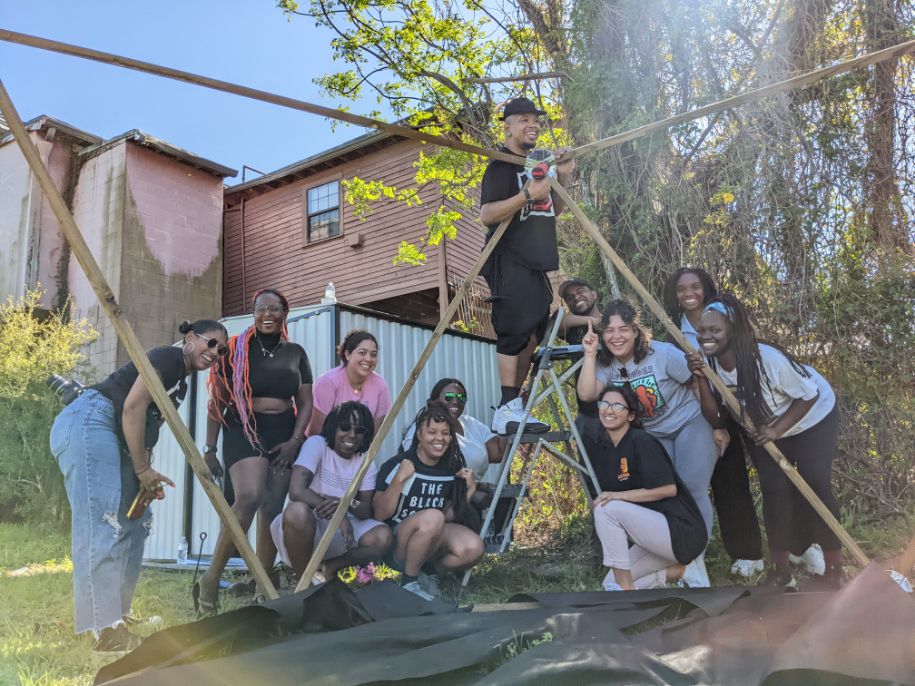
[ID: Twelve students pose around a wooden greenhouse frame, mid-construction. Some wear shirts with The Black School’s logo, some hold construction tools, and all are smiling towards the camera.]
Habits that I had developed around being creative that were natural to me had been pushed out of me, and it took a while for them to come back.
Allie: Yeah, all of those spaces on the margins, outside of the official classroom or teaching space are so important for that kind of continued conversation. Having those spaces to cook together and just be human together. To close out, I’d love to hear from you both on what questions or attitudes or mindsets you try to instill in your students. What do you hope that your students or participants will take away from your teaching?
Shani: We always start with these questions: What do you love about your community? And what do you want to change about your community? Which is super simple. The thing that is exceptional about that, especially in the context of this particular moment in the trajectory of public education in this country and the advent of charter schools, is that charter schools are imagined as this fix to public schools and ultimately to people. So you have urban education models, and all of this language was created to evade what they’re actually saying, but people feel what that is, which is that they’re treated as problems versus people and something to be solved versus educated.
We first ask, “What do you love?” because there are things to love. The inequity is real. Poverty leads to a whole lot of messed up circumstances. No shit. The poverty is the problem. Fix the poverty and then you don’t have to treat people like this. Even within the circumstances that so many people without money find themselves, in this country there is a lot to love. It’s still home. It’s still family. It’s still community. We want to focus on whatever folks’ answers are to that. Start with questions and start with opening up the space. What we’re going to do, we figure out together. We are always trying to strike that balance and remind people that there is the option of increasing what’s good as a solution to removing what is wrong. Those questions are really key. I think the other key is just demonstrating and creating a space where people can see and feel that they really do have some wherewithal to change what they want to change, be it on a personal internal level or societal, local, community, and so on.
Looking at American’s work about Octavia Butler and apocalypse, apocalyptic times are pretty clear. There’s a rational feeling of a sense of hopelessness, so I think demonstrating that there is still capacity and potential to impact things, to exert some control on your own reality. If people walk away with that, then we’ve done something right, and that’s the kind of thing that can replicate and have all of these additional positive effects on somebody’s life. So we try to start there on a fundamental level and figure out all the ways we can support those ideas and those possibilities going forward.
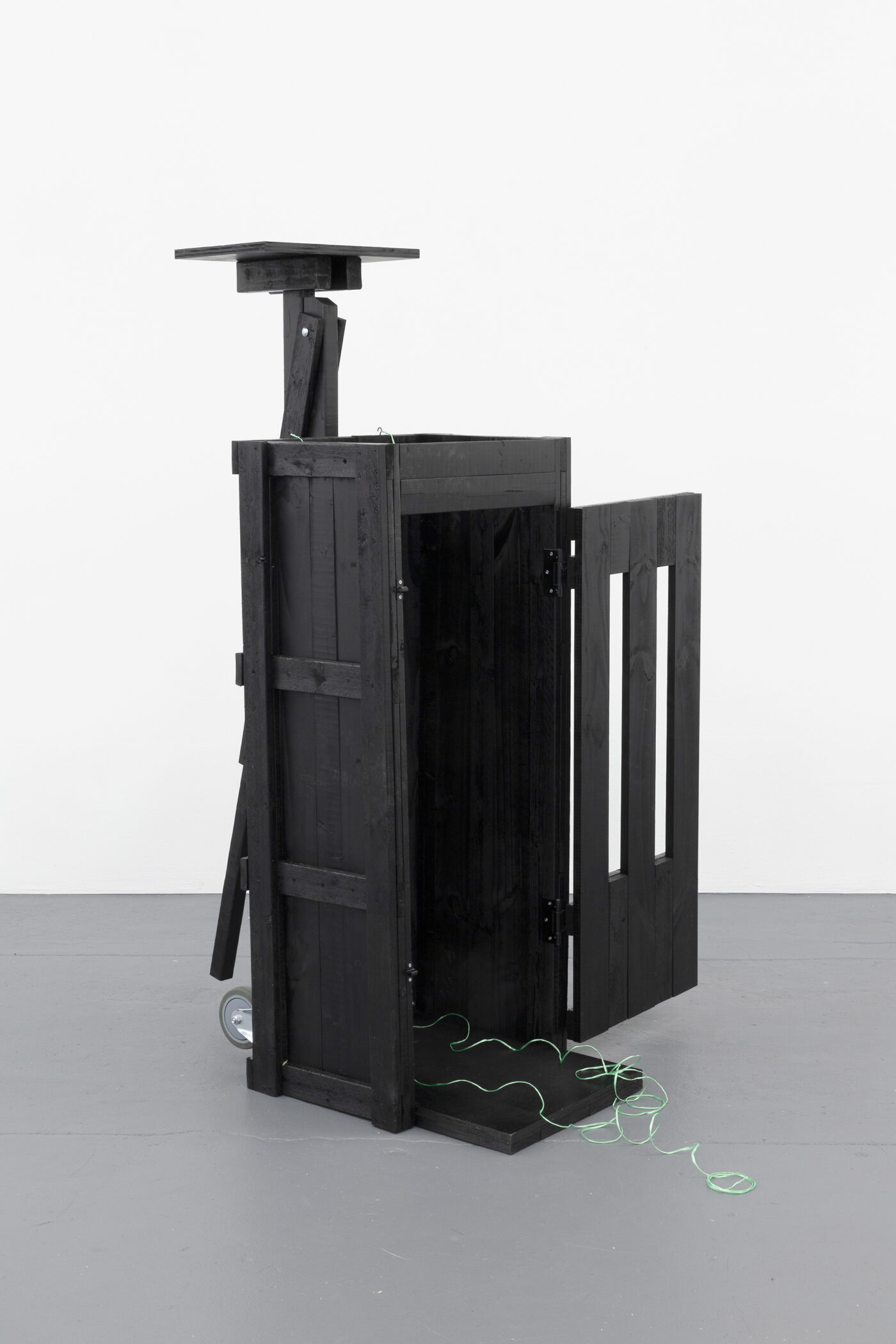
[ID: A box-shaped wooden object sits vertically and is painted black. It has a protrusion at the top and a door that is swung open. Out of the opening, green thread spills onto the floor. It is on a gray floor with a white background.]
Start with questions and start with opening up the space. What we’re going to do, we figure out together.
American: I love this idea you mentioned of increasing what’s good rather than removing what’s wrong, and I find it important to help students figure out what they want or what’s at stake for them, because I feel like in so many teaching spaces the expectation is to tell them what to do or change their behavior and punish them if they don’t change their behavior accordingly. I find that such an awful teaching model. Especially in art, when I was in school, I felt like there were a lot of people trying to tell me what I was supposed to be doing, and it took me a while after school for these things that were innate to me to return. Habits that I had developed around being creative that were natural to me had been pushed out of me, and it took a while for them to come back. I’d rather try and nurture what those are, because I think that’s the only way you can do something that is great, for lack of a better word, is if you feel inspired by it, and it feels like something you actually want to be doing. I feel like it’s key to listen to them and help them talk through what it is that you know they want and care about, and so that you can help them focus on that, and also take confidence in that and feel like that’s valid and that’s worth pursuing. It doesn’t feel like the way you’re supposed to be teaching if you’re doing that in university; it feels like you’re doing it wrong, because you’re not telling them what to do, or you’re approaching it in a more ambivalent way, but that’s the type of teaching that students are appreciative of because it gives them space to figure out who they are and what they want for themselves.
Shani: I think that’s a way to start to demonstrate every individual’s potential for impact. “I get a say in what’s happening in the classroom” then translates beyond there, as well.
I should say we definitely build so much of what we do from bell hooks’ Teaching to Transgress, Paolo Freire’s Pedagogy of the Oppressed. Simple ideas — we don’t have to reinvent wheels. People have been living through a lot of toxic, awful shit for a very long time, and so the models are there. We didn’t start off thinking this, but we’ve found that whatever it is we’ve wanted to do, even the most abstract, random, one-off ideas, like we wanted to make tetrahedral kites, and we were looking at Edison’s kites, and as we looked at these photos from Edison’s kite collective — there was actually a group — there was this Black guy, this random Black guy. Who’s he? What’s his story? Black people have already done everything. We have done the things. They’ve been burned down, they’ve been suppressed.
So whatever it is you want to do, there is a precedent for it, Black or otherwise. There’s a precedent for it and that can give you a roadmap of what to do, but it also can inspire and can show you that the narratives that we’re taught about who’s capable and who’s not are just so false.
American: Yeah, 100%. I’ve also been reading Teaching to Transgress. The straightforwardness with which she points out how damaging these teaching models are and questioning why is it like this, that’s how I feel going to the classroom, too, and you probably feel that, too. Why does it even need to be this way when it could be something that is validating and energizing and rewarding?
Shani: Like I said, I’m glad you all are doing this, documenting this, because I don’t have time. My dad was trying to tell me I need to write more. You don’t have time to do everything at once, so it actually feels necessary to have conversations like this because it helps to document along the way so that other people can pick it up in the same way we’re picking up bell hooks and all the others. Thank you.
American: Thank you.
Allie: Thank you both so much. This was a really special conversation, I appreciate it.
Note: This is a transcript of a conversation that took place via Zoom in June 2022. It has been lightly edited.
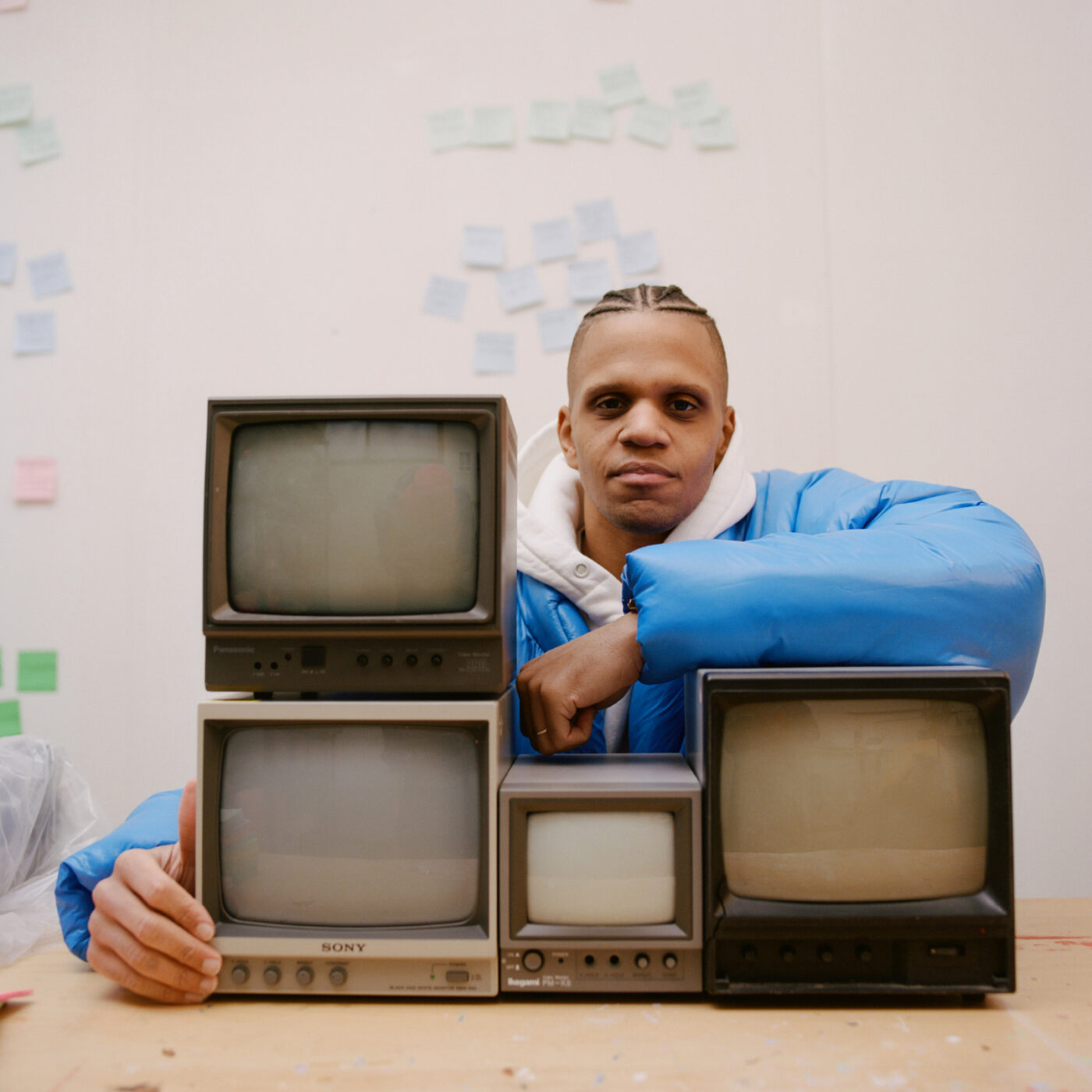
[ID: A portrait of a brown-skinned person in a blue jacket visible from the shoulders up. They are sitting behind a table that has four stacked small CRT monitors of various sizes. Their left arm rests on the monitors in the foreground and we see their head above that.]
American Artist
They // Them // Theirs
He // Him // His
New York, NY
American Artist makes thought experiments that mine the history of technology, race, and knowledge production, beginning with their legal name change in 2013. Their artwork primarily takes the form of sculpture, software, and video. Artist is a 2022 Creative Capital and United States Artists grantee, a recipient of the 2021 LACMA Art & Tech Lab Grant. They are a resident at Smack Mellon in Brooklyn and a former resident of Red Bull Arts, Abrons Art Center, Recess, EYEBEAM, Pioneer Works, and the Whitney Museum Independent Study Program. They have exhibited at the Whitney Museum of American Art; MoMA PS1; Studio Museum in Harlem; Museum of Contemporary Art Chicago; Kunsthalle Basel, Switzerland; and Nam June Paik, Center, Seoul. They have had solo museum exhibitions at The Queens Museum, New York, and The Museum of African Diaspora, California. Their work has been featured in The New York Times, Artforum, and Huffington Post. Artist is a lecturer at Parsons, NYU, UCLA, and a co-director of the School for Poetic Computation.
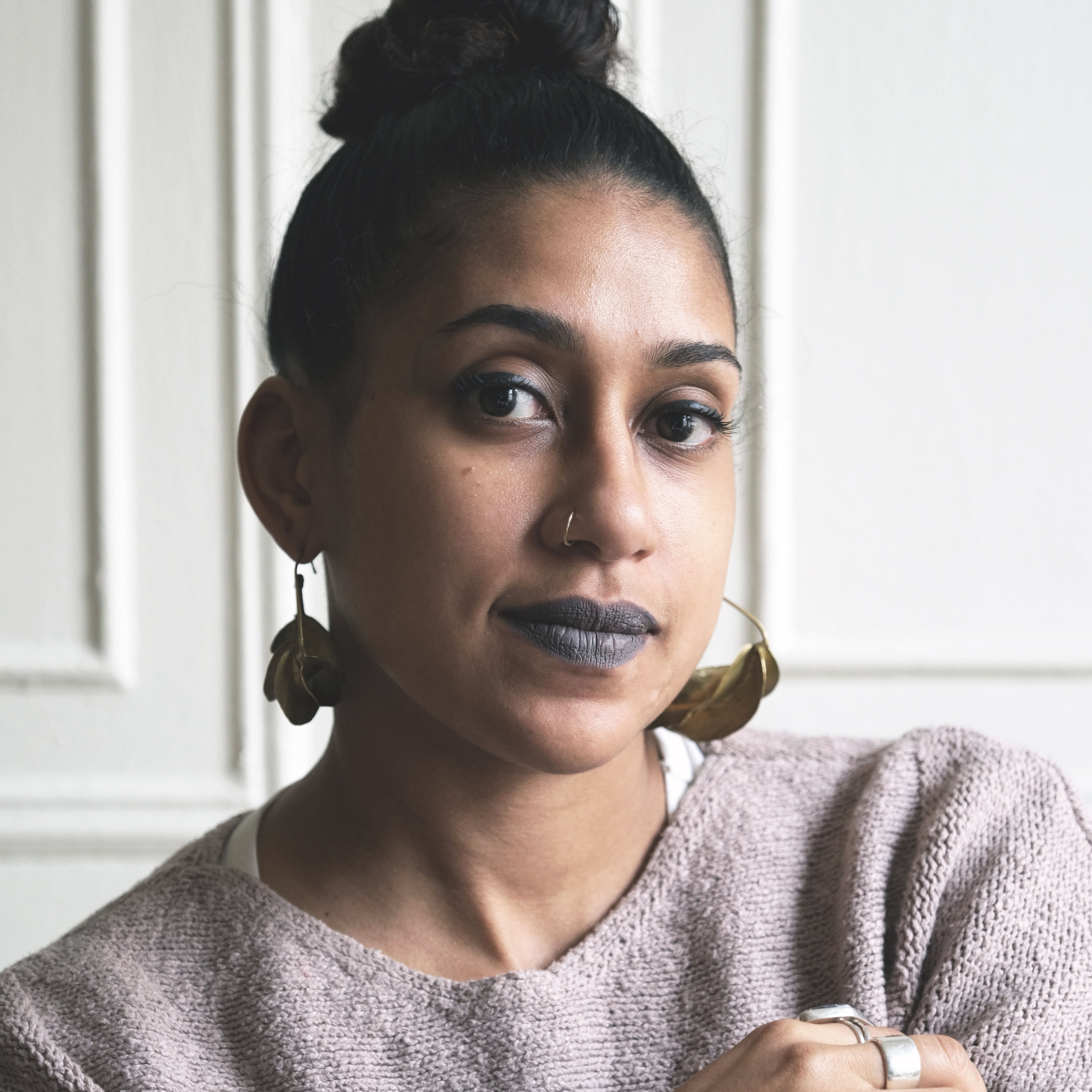
[ID: Shani, a Black woman with dark hair in a bun, looks at the camera.]
Shani Peters
She // Her // Hers
New Orleans, LA
Shani Peters (b. 1981, Lansing, MI) is a multidisciplinary artist based in New Orleans, LA. She holds a Bachelor’s degree from Michigan State University and a Master of Fine Arts from the City College of New York. Peters has presented work in the US and abroad at the New Museum, New York; The Schomburg Center for Research in Black Culture, New York; Seoul Art Space Geumcheon, South Korea; The National Gallery of Zimbabwe; and The Bauhaus, Dessau, Germany. Selected residencies include Lower Manhattan Cultural Council, New York; Museum of Contemporary Art Detroit, Michigan; The Laundromat Project, New York; and Project Row Houses, Texas. Her work has been supported by Creative Capital, Foundation for Contemporary Arts, the Robert Rauschenberg Foundation, Rema Hort Mann Foundation, and the Joan Mitchell Foundation. Peters was a faculty member at The City College of New York, Pratt Institute, and Parsons School of Design before shifting her teaching focus to The Black School, which she co-directs with Joseph Cuillier.
